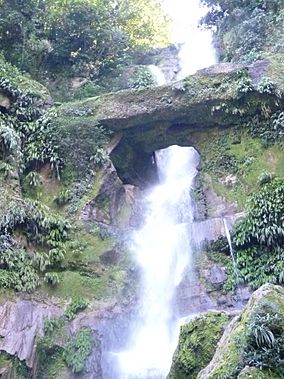Rio Abiseo National Park facts for kids
Quick facts for kids Rio Abiseo National Park |
|
|---|---|
|
IUCN Category II (National Park)
|
|
 |
|
| Location | Peru Huicungo District, San Martín Region |
| Area | 274,520 ha (1,059.9 sq mi) |
| Established | August 11, 1983 (by 064-83-AG) |
| Governing body | SERNANP |
| Type: | Mixed |
| Criteria: | iii, vii, ix, x |
| Designated: | 1990 (14th session) |
| Reference #: | 548 |
| Region: | Latin America and the Caribbean |
| Extensions: | 1992 |
The Rio Abiseo National Park (in Spanish: Parque Nacional del Río Abiseo) is a very special place in the San Martín Region of Peru. It is known for its amazing nature and ancient ruins. In 1990, UNESCO named it a World Heritage Site. This means it is important for everyone in the world to protect.
The park is home to many different kinds of plants and animals. It also has more than 30 pre-Columbian archaeological sites. These are places where people lived long before Christopher Columbus came to the Americas. Since 1986, the park has been closed to visitors. This is to protect its delicate natural environment and the old ruins.
Contents
Geography and Climate of Rio Abiseo
The park is located in the San Martín Region of Peru. It sits between two large rivers, the Marañón and the Huallaga. The park covers about 2,745 square kilometers (1,060 square miles). This area includes 70% of the Abiseo river basin.
Land Features and Elevation
The land inside the park changes a lot. Some parts are as high as 4,200 meters (13,780 feet) above sea level. Other parts are as low as 350 meters (1,150 feet). This big difference in height creates many different types of environments.
Different Ecosystems
Rio Abiseo National Park protects three main types of natural areas, called ecoregions:
- Ucayali moist forests: These are found in the lower parts of the park. They are warm and wet forests.
- Peruvian Yungas: These are at the middle heights. They are mountain forests with a lot of clouds and mist.
- Cordillera Central páramo: These are at the highest parts. They are cold, high grasslands.
Climate Zones and Rainfall
The park has at least seven different climate zones. These include montane forest, tropical alpine forest, and high Andean grasslands. Rainfall in the park can be from 20 to 80 inches (0.5 to 2 meters) each year.
The montane cloud forest covers most of the park. This is a high-altitude rainforest. It has short trees, lots of moss, and lichen. This type of forest grows above 2,300 meters (7,550 feet). It is always very humid, and it rains throughout the year. The soil in these areas is also quite acidic.
Wildlife in Rio Abiseo National Park

The park is very important for many animals. One of the most famous is the yellow-tailed woolly monkey, Oreonax flavicauda. People once thought this monkey was extinct, meaning it had died out completely. But it was found living in the park! This monkey is only found in this region. Its critically endangered status helped the area become a national park in 1983. This also helped it get listed as a World Heritage Site.
Animals Living in the Park
Many other animals also live in Rio Abiseo National Park. Some of them are:
- Andean guan
- Venezuelan red howler monkey
- White-fronted spider monkey (endangered)
- Jaguar
- King vulture
- Three-striped night monkey
- Curassaw
- Peruvian guemal (endangered)
- Mountain paca (endangered)
- Southern pochard duck
- Spectacled bear (endangered)
- Turkey vulture
- White-fronted capuchin monkey
- Hairy long-nosed armadillo
- Yellow-crowned amazon parrot
- Russet-mantled softtail (endangered)
- Yellow-browed toucanet (endangered)
Plants of the Park
The park is also rich in plant life. Scientists have found 980 different kinds of plants in the highlands of the park. Thirteen of these plants are found nowhere else in the world. Overall, there are about 5,000 species of plants in the entire Rio Abiseo area.
Archaeology and Ancient Sites
Rio Abiseo National Park is not just about nature; it's also a treasure chest of ancient history. Many old settlements and ruins are hidden within its forests.
Gran Pajatén
The most famous archaeological site in the park is Gran Pajatén. This is a ruined settlement located high up on a forested ridge. It looks over the Montecristo River canyon. The buildings here are made of stone and decorated with carvings.
Los Pinchudos
Close to Gran Pajatén are the ruins of Los Pinchudos. These are a series of cliff tombs. Local villagers from Pataz found them in the early 1970s. These tombs are built into the side of cliffs.
The Chachapoyas Culture
Gran Pajatén, Los Pinchudos, and other ruins in the park are usually linked to the Chachapoyas culture. The Chachapoyas were an ancient civilization that lived in the cloud forests of the Andes. They were known for their unique architecture and burial practices. The most detailed archaeological work in Rio Abiseo Park was done by the University of Colorado at Boulder in the mid-1980s.
See also
 In Spanish: Parque nacional del Río Abiseo para niños
In Spanish: Parque nacional del Río Abiseo para niños
- Iperu, tourist information and assistance
- Tourism in Peru


